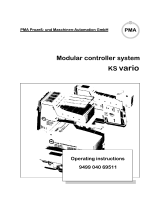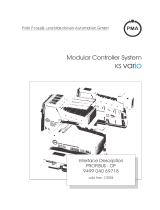Page is loading ...

PowerPower supplysupply modulemodule forfor sensors,sensors, VARIOVARIO COCO 2/U,2/U, orderorder no.no. KSVC-103-02221KSVC-103-02221
11 GeneralGeneral
The vario power supply module for sensors is used for energizing transmitters, especially strain gauge or semi-conductor bridges for
pressure sensors within the KS vario/vario system.
The module provides a supply voltage for pressure sensors, which is isolated from the remaining system.
2 Technical data:
Supply voltage: 24 V d.c. (from the analog voltage (Uana) of the vario station.
Current consumption: approx. 120 mA
Output voltage: 2 x 10 V d.c. constant voltage outputs for energization of 1 or 2 strain gauge pressure sensors
Output current: 2x40mAor1x80mA.Thesummust not exceed 80 mA.
Accuracy: typ. 0,6 %
Drift: typ. 0,3 %
Short circuit protection: max. 1 h
Galvanic isolation: isolated from the supply voltage (Uana), outputs galvanically connected.
Display element: 1 LED, yellow, for indication of the output voltage
Connection technique: cage clamp, 2-wire connection with screening
Dimensions: 12,2x120x76mm
Weight: approx. 70 g
Temperature range: operation: -25 °Cto55°C storage/transport: -25 °Cto85°C
Humidity: operation/storage/transport: average 75 %, 85 % occasional
Protection type: IP20 to IEC 60529
Bus interface: not required, however, the internal bus is looped through the module.
Accessories: connector, inscription field (delivered with the unit)
3 Pressure sensor connection
Normally, pressure sensors consist of a full bridge circuit which must be energized by a voltage galvanically isolated from the system.
The diagonal voltage is applied to a controller module input (mV), which is configured accordingly.
Sensor calibration is by means of a built-in resistor of a defined value in the pressure sensor. Without pressure applied, the resistor
changes the bridge resistance so that 80 % nominal output voltage are available at its output. The relevant values are given in the
pressure sensor data sheet. This resistance can be connected in parallel to a bridge arm by an external relay, whereby this ???
resistance change is caused.
The following relay modules are provided:
VARIO relay output module VARIO DO 1/230, order no. KSVC-102-01211 or VARIO relay output module VARIO DO 4/230, order
no. KSVC-102-01231.
These modules permit control of the relay, i.e. bridge resistance change, via the system bus.
When using these relay modules, the following information must be taken into account:
For using the module for switching the calibrating resistor, the only load must be the calibrating resistor. The sparks generated by
higher currents/voltages cause contact consumption and increase the contact resistance, i.e. correct switching of a "dry circuit" is not
ensured any more. The relay modules should be always at the right end of a KS vario station. In these modules, the voltage Uband
Us(both 24V) are interrupted. Consequently, these voltage would have to be fed in again behind the relay module.
The connector of a relay module (colour: median gray) must not be plugged into other modules, because when using for purposes
varying from the "calibrating relay", higher voltages (230 V AC) may also be applied to the contacts. These can destroy the
components of the contacted module components unless plugged in correctly.
Although this connector is coded mechanically for protection against being inserted completely into other modules by closing of
contact holes 1.1 and 2.1, electrical connections can occur even with partial faulty connection.

For extending the cable fitted to the pressure sensor, the same or a very similar cable type must be used (6-wire, screened).
The screening earth connection must be made via the function earth (FE). The screening is connected to earth only with a non-
interrupted connection up to the bus coupler module provided. (The function earth is looped through all modules and connected to
earth centrally at the bus coupler module.
4 Maintenance and behaviour in case of fault
The power supply module for sensors and the relay module do not need particular maintenance and no components require any
preventive maintenance or care.
4.1 Trouble shooting
To start with, all possibilities of trouble sources due to connected instruments and cables (input leads, wiring, equipment connected in
the output circuit) should be checked. Unless the trouble was found after these checkings, the instrument must be returned to the
manufacturer:
PMA Prozeß- und Maschinen-Automation GmbH
Service-Abteilung
Miramstraße 87
D 34123 Kassel
49 561 505 1307
If the trouble is found to be due to failure of a fuse, the cause must be determined and corrected. The spare fuse must have the
same rating as the original type.
Unless the LED is lit despite intact fuse and correctly connected supply voltage, the bus coupler is defective and must be returned to
the manufacturer for repair.
4.2 Shut-down
Before disconnecting the unit, disconnect the system completely from the supply
voltage and check that other equipment connected in the overall system is not
effected.
WARNING! WARNING!
When the instrument is suspected of being unsafe, it must be taken out of operation and protected
against accidental switch-on.
5. Relevant for ULonly
Ambient temperature max. 55˚ C
Temperature range of the cables 60/75˚ C
Use copper conductors only for power supply connection.
to be used in a pollution degree max. 2 environment.
©PMA Prozeß-und Maschinen-Automation GmbH
Postfach 31 02 29, D - 34058 Kassel
Subject to change without notice
Printed in Germany 9499-040-73011 (10/2005)
/









